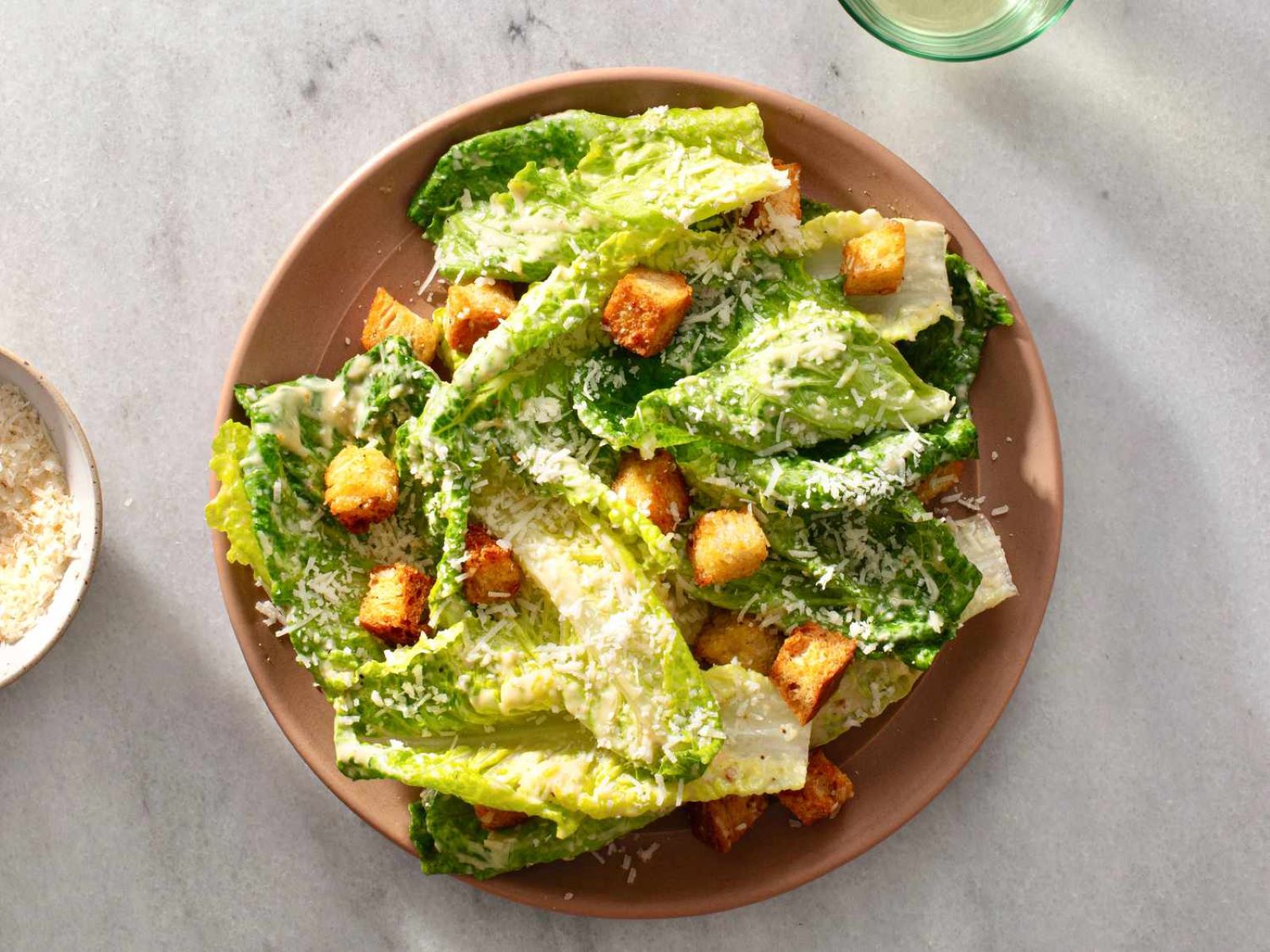
When it comes to classic salads, few can rival the popularity of Caesar salad. This beloved dish is a staple in many restaurants and households, known for its simplicity and robust flavors. But besides being delicious, have you ever wondered about the nutritional value of Caesar salad?
In this article, we will explore 19 Caesar salad nutrition facts that will give you a deeper understanding of what you’re consuming when you enjoy this iconic salad. From the greens to the dressing and everything in between, we’ll break down the nutrients, calories, and health benefits of each component. So, whether you’re a Caesar salad connoisseur or simply curious about its nutritional profile, keep reading to uncover the secrets behind this popular dish.
Key Takeaways:
- Caesar salad is a versatile and nutritious dish that can be customized with protein and made vegetarian. It’s a low-carb option and a good source of vitamins, but moderation is important due to the calorie content.
- Caesar salad is a crowd-pleaser that can be enjoyed year-round. It pairs well with grilled meats and can be made healthier with substitutions. It’s easy to make at home and can be a complete meal with added protein.
Caesar salad is a classic dish
The Caesar salad is a beloved classic dish that has stood the test of time. It is known for its combination of crisp romaine lettuce, tangy Caesar dressing, crunchy croutons, and savory Parmesan cheese.
It was created by Caesar Cardini
The Caesar salad was invented by a restaurateur named Caesar Cardini in the 1920s. He came up with the recipe on the fly when running low on ingredients and it became an instant hit.
The dressing is the star
One of the key elements of a Caesar salad is the dressing. It is made from a mixture of garlic, anchovies, egg yolks, Dijon mustard, Worcestershire sauce, lemon juice, olive oil, and Parmesan cheese. It provides the salad with its characteristic flavor.
Anchovies are a traditional ingredient
Traditionally, Caesar salad dressing includes anchovies as an ingredient. They add a unique umami flavor to the dressing, but can be omitted for those who don’t enjoy them.
It can be customized with protein
While the original Caesar salad doesn’t traditionally include protein, it is common to add grilled chicken, shrimp, or salmon to make it a more substantial meal.
It is a low-carb option
For those following a low-carb diet, a Caesar salad is a great choice. The combination of lettuce, dressing, and protein (if added) can make for a satisfying and nutritious meal.
It is a good source of vitamins
A Caesar salad made with fresh romaine lettuce is a good source of vitamins A, C, and K. These vitamins support immune function, promote healthy skin, and contribute to bone health.
The croutons add crunch
Croutons are a staple in a Caesar salad. They provide a satisfying crunch and act as a contrast to the crisp lettuce leaves. However, they can also add carbohydrates and calories to the dish.
Parmesan cheese adds calcium
Caesar salads typically feature Parmesan cheese, which provides a source of calcium. Calcium is essential for healthy bones and teeth.
It can be made vegetarian
A Caesar salad can easily be made vegetarian by omitting the anchovies and using a vegetarian Worcestershire sauce. This allows individuals with dietary restrictions or personal preferences to enjoy the dish.
Moderation is key
While a Caesar salad can be a nutritious choice, it is important to practice portion control. The dressing and added ingredients can increase the calorie content of the salad if not consumed in moderation.
It pairs well with grilled meats
The flavors of a Caesar salad complement grilled meats such as steak or chicken. The freshness of the salad acts as a light and refreshing accompaniment to the smoky flavors of the grilled meat.
It is a popular restaurant menu item
Caesar salad is a staple on many restaurant menus. Its popularity stems from its versatility and wide appeal among diners.
It can be enjoyed year-round
Caesar salad is not limited to a specific season and can be enjoyed year-round. Its refreshing flavors make it a suitable choice for any time of the year.
It can be made healthier with substitutions
For those looking to make a healthier version of a Caesar salad, there are various substitutions that can be made. Using a light dressing, replacing croutons with nuts or seeds, and adding additional vegetables are some options.
It is a versatile dish
Caesar salad can be customized to suit individual preferences. Additional ingredients such as cherry tomatoes, avocado, or bacon can be added to enhance the flavors and textures of the salad.
It is a crowd-pleaser
Whether at a family gathering, potluck, or dinner party, a Caesar salad is often a crowd-pleaser. Its combination of familiar flavors and textures makes it a safe choice for a variety of tastes.
It can be a complete meal
With the addition of protein, a Caesar salad can be a complete and satisfying meal. It provides a balance of carbohydrates, protein, and fats, making it a filling option.
It is easy to make at home
A Caesar salad can easily be made at home with a few simple ingredients. This allows individuals to control the quality of ingredients and customize it to their liking.
Conclusion
In conclusion, Caesar salad is a popular and delicious choice for a nutritious meal. It offers a wide range of benefits such as being a good source of vitamins, minerals, and antioxidants. The combination of fresh romaine lettuce, tangy dressing, and savory toppings creates a flavor-packed dish that is both satisfying and healthy. However, it is important to note that the nutritional content can vary depending on the specific ingredients used and portion sizes. It is always a good idea to be mindful of portion control and choose healthier options for dressings and toppings to maximize the nutritional value of your Caesar salad. So go ahead and enjoy this classic salad, knowing that you are nourishing your body with essential nutrients.
FAQs
1. How many calories are in a Caesar salad?
The number of calories in a Caesar salad can vary based on the ingredients and serving size. On average, a traditional Caesar salad with dressing, romaine lettuce, croutons, and Parmesan cheese can range from 400 to 600 calories.
2. Is a Caesar salad a healthy choice?
Caesar salad can be a healthy choice, especially when made with fresh and nutritious ingredients. Opt for using a lighter dressing or make your own with low-fat yogurt or olive oil. Additionally, adding protein-rich ingredients like grilled chicken or shrimp can make it a more balanced and filling meal.
3. What are the main nutrients found in Caesar salad?
Caesar salad is rich in several essential nutrients. Romaine lettuce provides vitamins A and K, while Parmesan cheese offers calcium and protein. The dressing typically includes olive oil, which contains heart-healthy fats. Additionally, croutons can contribute to the carbohydrate content of the salad.
4. Can I make a vegetarian version of Caesar salad?
Absolutely! You can easily make a vegetarian version of Caesar salad by omitting the anchovies from the dressing. There are also plant-based alternatives available that mimic the flavors and textures of traditional Caesar salad, making it suitable for vegetarian or vegan diets.
5. Are there any gluten-free options for Caesar salad?
Yes, you can make a gluten-free Caesar salad by using gluten-free croutons or omitting the croutons altogether. Check the labels of store-bought dressings to ensure they are gluten-free, or make your own dressing using gluten-free ingredients.
Was this page helpful?
Our commitment to delivering trustworthy and engaging content is at the heart of what we do. Each fact on our site is contributed by real users like you, bringing a wealth of diverse insights and information. To ensure the highest standards of accuracy and reliability, our dedicated editors meticulously review each submission. This process guarantees that the facts we share are not only fascinating but also credible. Trust in our commitment to quality and authenticity as you explore and learn with us.


